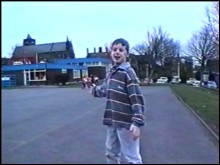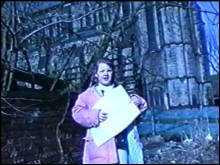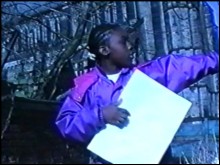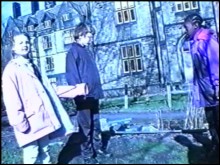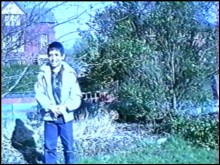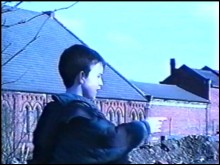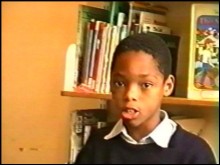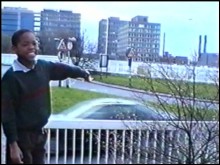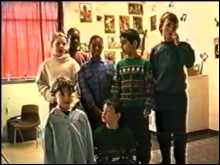Centre for Creative Media Research > Video Critical
Blenheim Primary School: Making the video
|
|
This group, interviewed in the first week of the project, had a moderate amount of knowledge about environmental matters and problems, and seemed reasonably concerned about the subject. When asked what the environment is, they suggested 'nature', but also 'Greenpeace'; and were able to list environmental problems such as 'throwing litter', 'waste', 'pollution', 'sewage', and 'cutting down trees to make paper'. 'Recycling' was given as a solution to this, and the children were able to name many recyclable products. Anna was able to explain acid rain and how it occurs, and about the ozone layer and how it protects the earth. They had learnt a song about pollution (featured in the video), which they performed on the spot. They explained that the song is about air pollution and water pollution. Discussion later developed about whether people would all be best off moving to the North Pole. As the completed video clearly shows, the children were particularly animated and interested when they could focus on particular environmental matters on their doorstep. They went about making the video with considerable enthusiasm and were frequently coming up with ideas - some of them much too adventurous for the time available - of new things to do. Whilst the idea of writing to the Council was suggested by their class teacher, the disgust with the site was their own, as was the idea of telephoning the Council with their enquiry - which was a particularly good and unusual sequence to capture on videotape. The children's letters to the Council were notable for going beyond the most basic possible form, again reflecting their interest in the subject. The group also seemed keen to produce material, such as songs and poems, in their own time, for the video - the most notable product of this being Charlotte and Rebekah's song, which opens the presentation. Interviewing each other about the environment, the group became quite authoritarian on behalf of the environment, calling for fines and prosecutions for those who drop litter, or messily trespass on the school grounds. They were also full of suggestions for improvements which could be made, such as the planting of further trees and flowers, and the provision of more litter bins. Their poems reflected a generally positive feeling about the school, combined with concern primarily, again, about litter. In the final week, once the Council's replies had been received, there was a lengthy discussion about what the children themselves would like to see the waste ground used for. A detailed - and at times wildly ambitious - plan emerged for a multi-level community centre serving elderly people, disabled people, the homeless and youth, the most basic details of which are presented in the video. The children's image of disabled people was positive, with their thoughts turning immediately to sporting activities for them. Summary This video had a more distinct structure than most, beginning with an assessment of the school environment, moving into criticism of the waste land at the bottom of the school field, followed by the attempts to find out what the Council intended to do, and then reaching some resolution with the children's own ideas for the site. Other material about the environment also appeared throughout. The children had been moderately concerned about the environment generally at the start of the project, and the process of making the video seemed to have developed their awareness of local problems, and led them to consider the area more imaginatively. After the screening of the completed video, both the class teacher and the classroom assistant were extremely impressed with the work which the children had produced, since they had not been the most 'able' children, but represented a range of abilities across the middle band. Their comments suggested that the video project had brought out abilities in the children which, in some cases in particular, had previously been less than conspicuous. |
![]()
The text and images on this site are by David Gauntlett, © 1997, 2004.
Back to > Video Critical home.

